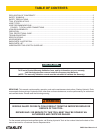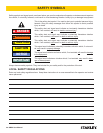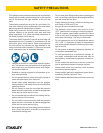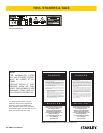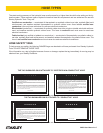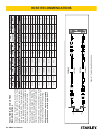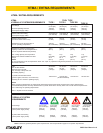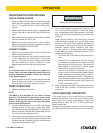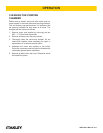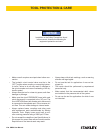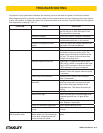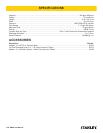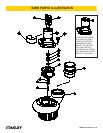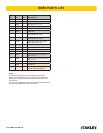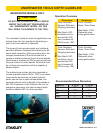
SM50 User Manual ◄ 13
If symptoms of poor performance develop, the following chart can be used as a guide to correct the problem.
When diagnosing faults in operation, always make sure the hydraulic power source is supplying the correct hydrau-
lic ow and pressure as listed in the table. Use a owmeter know to be accurate. Check the ow with the hydraulic
uid temperature at least 80 °F/27 °C.
PROBLEM CAUSE SOLUTION
Pump will not start. No hydraulic uid ow or pressure. Turn on power unit and check that 7–12
gpm/26–45 lpm at 1000-2000 psi/70–140
bar is available at the pump.
Defective couplers. Check the couplers. Replace if necessary.
Impeller jammed with debris. Clean the pumping chamber as described in
the Maintenance section in this manual.
Impeller rubbing against wear
plates.
Check and adjust the impeller clearance as
described in the Service Manual.
Defective hydraulic motor. Repair or replace motor.
Poor pump performance. Hydraulic ow reversed. Check that the hoses are correctly
connected to the pump motor ports. The
female coupler should be connected to the
“IN” port. The return uid must never ow
through a reversing valve.
Improper hydraulic uid ow. Check that 7–12 gpm/26-45 lpm at 1000–
2000 psi/70–140 bar is available at the trash
pump. A 20% decrease in ow can result in
a 50% decrease in pump performance.
Pump submersed in sediment. Lift the pump from the bottom of the hole or
chamber. Use a at support under the pump
if necessary.
Trash pump inlet restricted. Remove suction screen and thoroughly
clean. Reassemble.
Discharge hose kinked or
restricted.
Straighten the hose. If the hose must bend
at the top of the hole, use a piece of split
rigid conduit with large diameter of the
expanded hose. This keeps the hose from
kinking.
Discharge hose too small. Use a 3-inch diameter re hose.
Water lift too high. Lower the outlet end of the discharge hose.
Increase hydraulic ow (12 gpm/45 lpm
max).
Impeller worn or damaged. Check impeller for damage and excessive
wear. Replace if necessary.
Pump not matched to application Obtain higher capacity pump.
Hose used on suction side of
pump.
Remove. Use no plumbing on suction side
of pump.
Poor pump performance
with excessive wear.
Too many solids in the water.
Water speed out of the hose may
be too slow, therefore hose and
pump load up with solids.
Reduce solids content. Increase pump
speed.
TROUBLESHOOTING



